
I have a favorite tree. It is a Scarlet Oak (Quercus coccinea). The scarlet designation comes from its bright fall red foliage that will be apparent when we get to October.
The Scarlet Oak is native to East and Central US. It is a beautifully shaped tree and is often used as a featured ornamental in landscaping as it is here in a city park situated along Bellingham Bay.
I have enjoyed this tree for a long time and have photographed it off and on as time presented and as I watched the sun move across the bay and the islands. The sun traverses the bay arcing through the year to one solstice and then back again. As the sun changes its position across the seasons the tree changes its persona as the sun journeys round the bay. This is a tree for all seasons with the bay, the San Juan Islands, the Lummi Peninsula and sunsets as its backdrop. The park is Marine Park, one that I have photographed over the years. However, I have never given this magnificent tree the due that it deserves until now.
Phenology
Although Phenology is a concept that most readers know although many don’t have a sname for it. So, good ole Wikipedia helps us out and tells us that the term…
” …is from the Greek φαίνω (phainō), “to show, to bring to light, make to appear”[2] + λόγος (logos), amongst others “study, discourse, reasoning”[3] and indicates that phenology has been principally concerned with the dates of first occurrence of biological events in their annual cycle.
This post will show the comings and goings of this tree’s phenologic changes from solstice to solstice. It is also a solar romp across the seasons and of course the two are intimately related.
Setting and location:
Marine Park is popular and as you will see, numerous human activities happen in and around this tree including picnics, tree climbing, beachcombing, shell picking up, kayaking, kayak polo competition and sunset watching. We also watch various working and pleasure boats passing to and from the islands such as the Alaska Ferry on Tuesdays and Fridays and the occasional freighter transporting logs to China and frozen foods to Russia.
Our location is important to understand both for the phenology and its relation to the celestial wanderings as we are rather far north. We are further north than any other area in the “lower 48”. In the winter the sun sets very (too) early (4:15) and in the summer rather late (9:16, with light in the sky until 11:00). The 49th parallel/latitude (think Canada) is just 19 miles north of the tree whose coordinates are 48° 43’ 8” North, 122° 30’ 58” West.

Google earth screenshot of Bellingham Bay, lummi Island and Lummi Peninsula in relation to the tree in Marine Park. The tree is the yellow pin in the lower right. Sun sets at Winter Solstice over Lummi Island at pin in the lower left (234° ) and at Summer Solstice over Lummi peninsula, upper pin (308°). The tree is visible on Google Earth.
I do not have a specific photo of each month or when each leaf appeared and fell. but I do have some to illustrate the seasons and the tree’s phenology. Many of the photos are largely silhouettes as they were taken at sunset to illustrate where the sun went down. Also you will note that the photos are taken at somewhat different orientations to the tree in order to get the sun in as it set and moved across the islands over time.
December:
We start at December and the Winter Solstice when the sun sets furthest south (234°). However, its earliest set is actually a few days before the solstice when it sets two minutes earlier. But it is a very short day with only 8 hours, 15 minutes and 49 seconds of daylight.
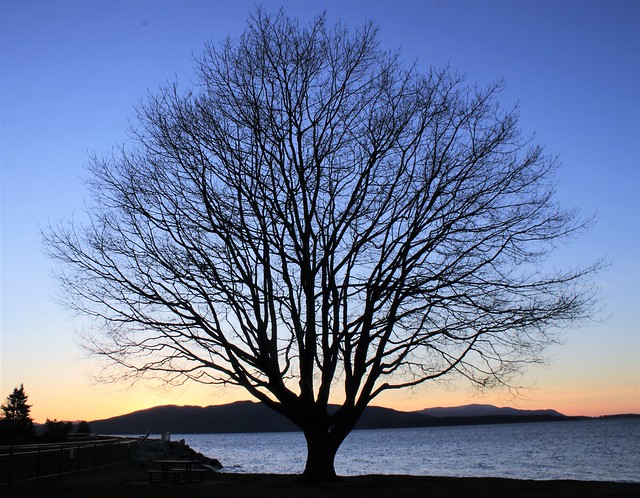
Winter solstice, (4:15 pm, December 21, 2017). Sets at 234°, WSW
I have a second favorite tree at the park too. It is a European White Birch (Betula pendula). Although some Birch trees are native to this area, this one is an imported ornamental.

European White Birch, December 9, across bay and Lummi Island.
And lest you are left with the impression that the sun always shines up here in the PNW, check this foggy December shot.

February:
By February the sun is staying up another 22 minutes and is moving to the west, setting at 254°.
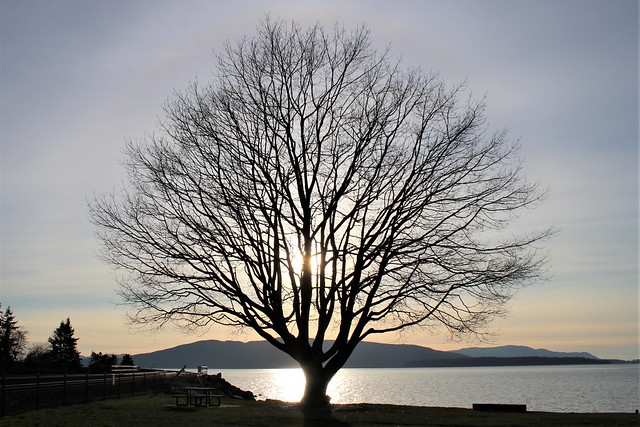
February 19, setting soon at 5:37pm. Lummi Island directly behind and Orcas Is. to the right
March:
Moving along to March we see some significant change. In the photo below you can see that the setting sun has moved pretty much the length of Lummi island and is setting behind Orcas Island. It is setting at 6:01, 24 minutes later than the previous photo.
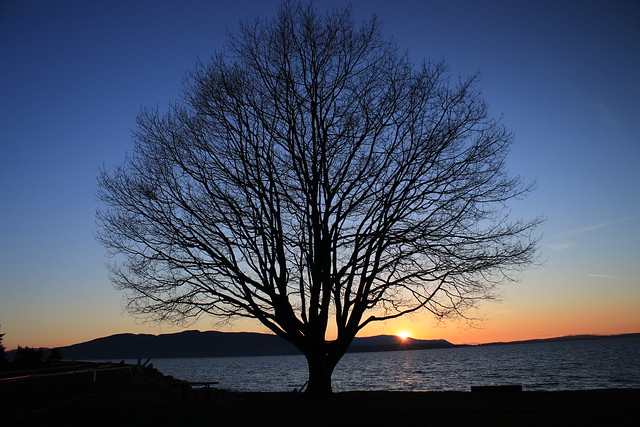
From this March 6th shot, we can not yet see any budding but we know the tree is itching to get some clothes on.
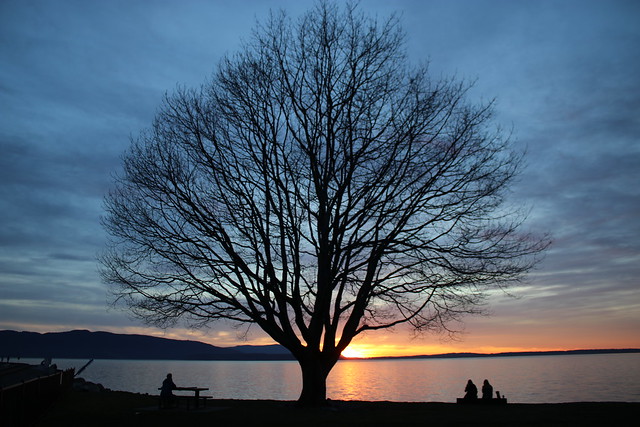
About a week later, March 12, the sun has continued to move westward, now setting at 266° and at 7:10 (DST). No phenological change yet but just wait.
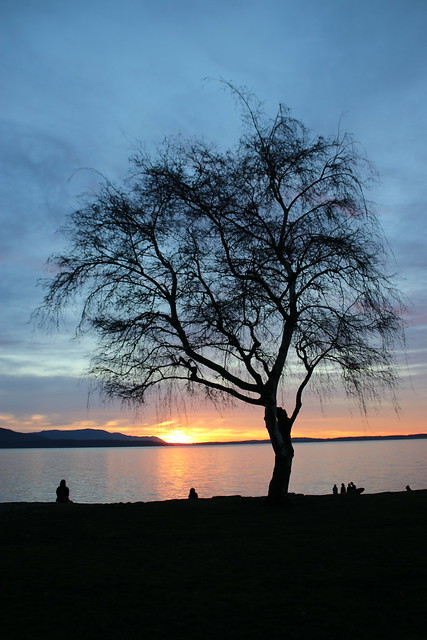
The White Birch is waiting too on the 12th.
April:
Both the tree and local kayakers are starting to come out their winter’s hiding. It is April 17th here, the tree is starting to bud out and local kayak polo competition is now on just off the park’s beach. And of course the sun has now moved past due west and is setting here at 287° at 8:01 pm.
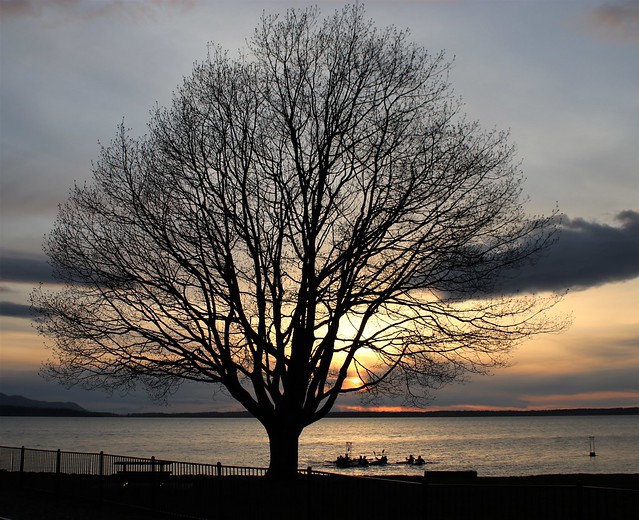
Kayak polo teams competing at sunset under the budding Oak.
May:
May brings the tree to fuller leafing as people bundle up to watch the sunset.

May 6th and the oak tree is continuing to feather itself. A few clouds to the west partially obscure the sun setting but provide some pastels.
A week later and the tree is just about fully leafed and the sun continues to roll north.
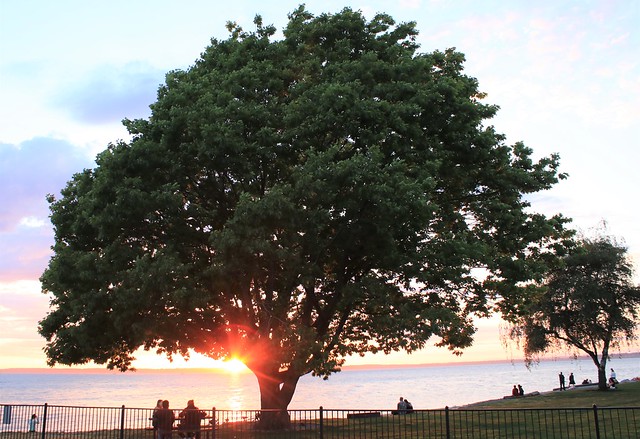
May 23, 8:50 pm. setting at 304°, with picnickers under the tress. The White Birch is to the right.

The White Birch is now fully leafed out too (May 23, 8:55 pm, 304°)
June:
Summer solstice is technically June 21, although length of day on the 20th is virtually identical, differing by just a small fraction of a second.
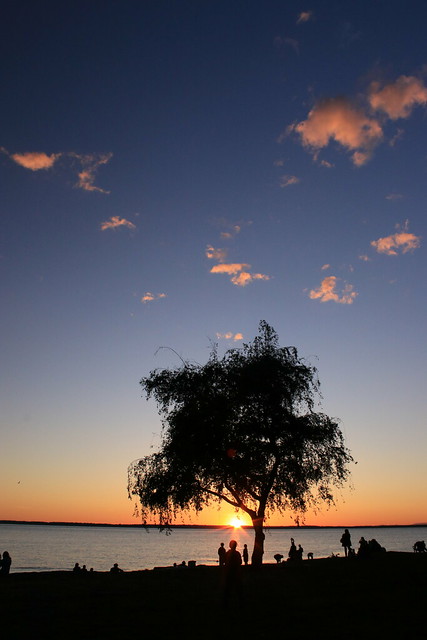
The Birch on June 16th, 9:14
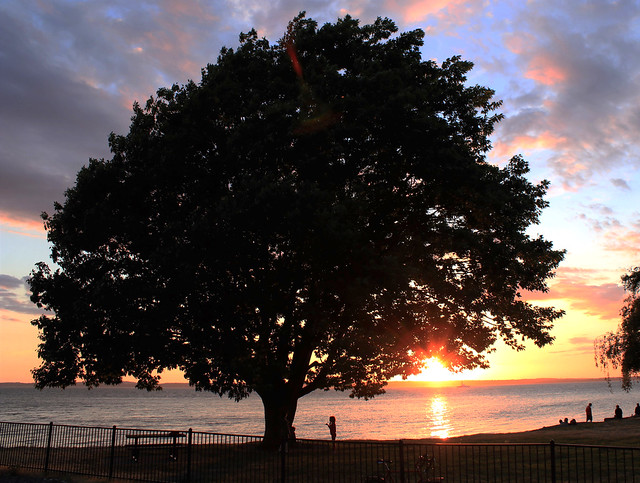
The end of Spring and the beginning of Summer with the Scarlet Oak outfitted to the nines for the Solstice, June 21st.
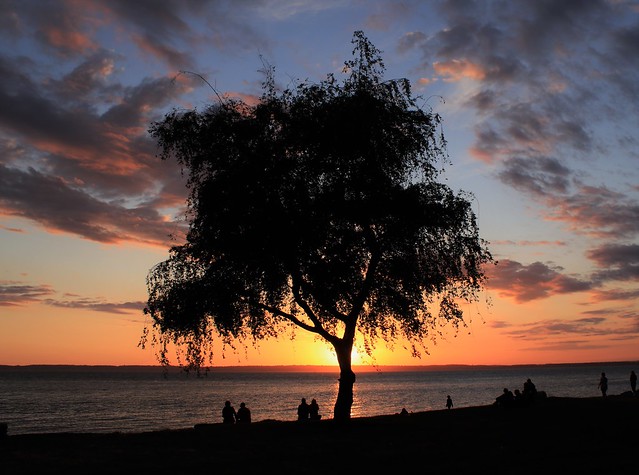
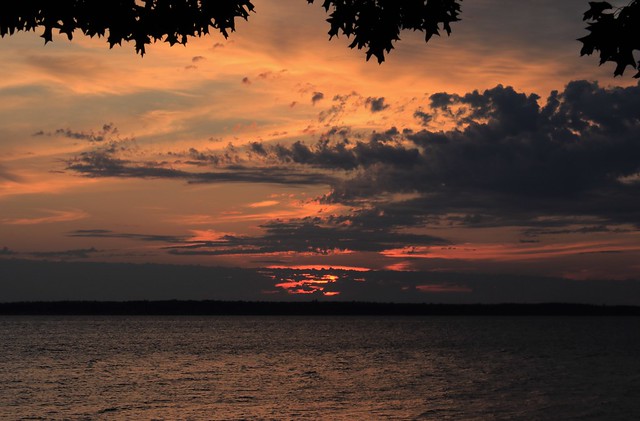
One last shot from under the oak tree at Spring’s end. Sun setting at 308°, over the Lummi Peninsula
October:
We have to wait all the way into October to see why this wonderful tree has the moniker of “Scarlet Oak.” It is clearly aptly named.
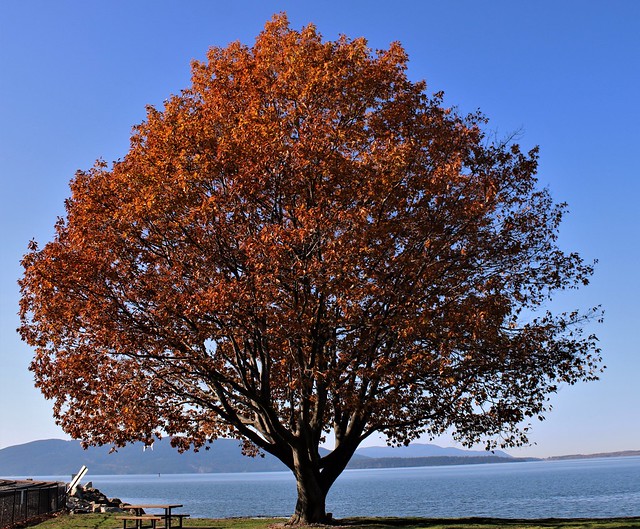
Scarlet Oak in its eponymous colors on a bright October 30th
And there you have it – Bellingham Bay and the Scarlet Oak across the seasons with and without finery. A great tree either way.

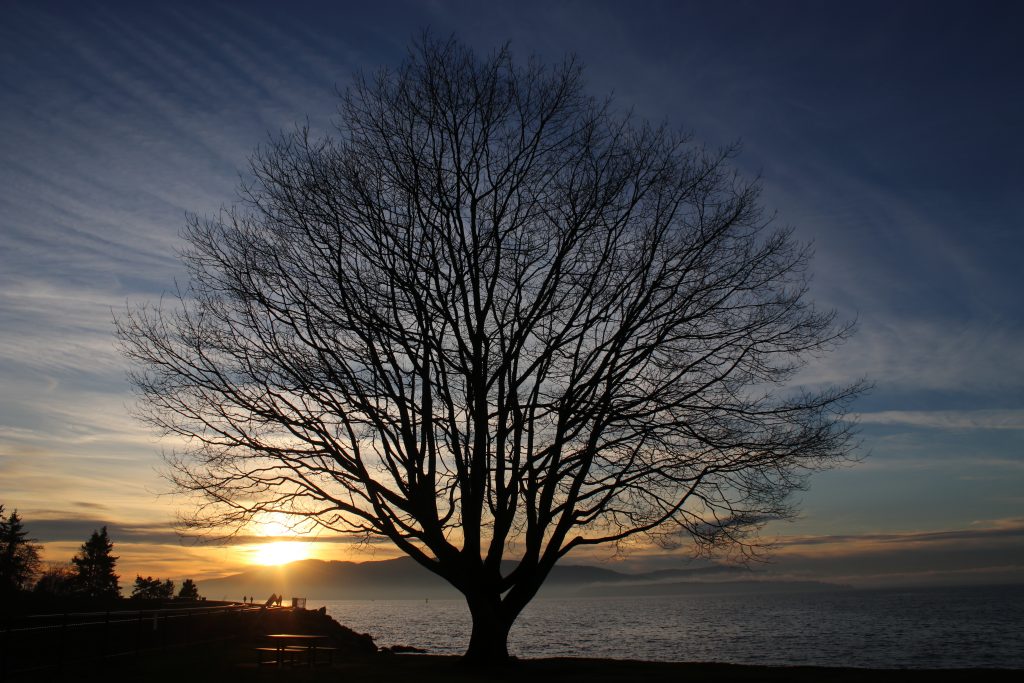
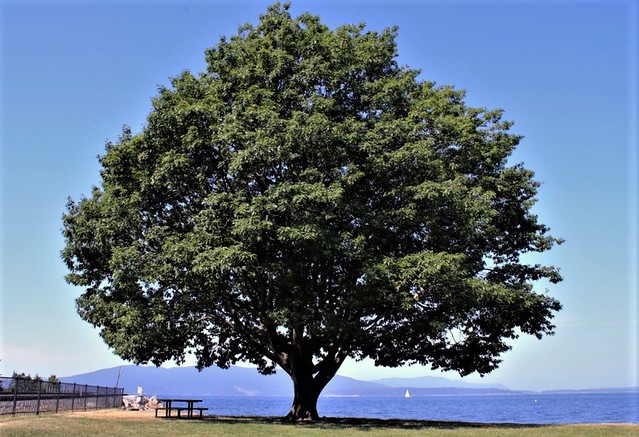
You had me at “tree”! There is nothing I love more than watching the cycle of the seasons and the cycle showing a tree transforming for an entire year is spectacular. I do something similar on my personal web site – the header is a photo from my back deck of the same scene as the seasons change (when I remember to change it!).
I love the winter trees when the twists and turns of the branches are visible. I love the early spring when the buds begin to form and the tree starts looking “rounded” in the distance. The fully leafed out tree of July is beautiful and the tree in fall foliage is probably my favorite.
Thank you for this post, RonK!
Thanks JanF. We are clearly of a like mind on watching trees as the seasons change. This tree has such a classic tree structure in all of its seasonal appearances.
What a beautiful photo essay, Ron K! I’ve bookmarked to come back to later today after my walk and errands are done. Will comment more later.
I love trees. Shoulda been a Druid.
Thanks Diana,
Druids did center on oak trees as I recall. They had good taste in trees.
{{{RonK}}} – what a lovely photo essay of the seasons & the tree. Different cultures count the seasons different ways – our culture counts solstice/equinox, basically tracking heat. (hottest part of the year is summer solstice to autumnal equinox). Others track light (most light from May/Beltane to August/Lammas). I think the trees count the seasons by light. ???????????? Thank you again. moar {{HUGS}}}
Thanks for your interesting comments bfitz.
Came back to this gorgeous photoessay tonight to gloat over the pictures and savor the text. Your love for the scarlet oak is entirely understandable—it’s magnificent.
It is completely fascinating and new to me that you have such short winter days in your part of the country, Ron K. It gets completely dark in England at 4 p.m. in the winter, but I hadn’t realized that it happens in the Pacific Northwest too. The clear skies of winter afternoons are my favorite part of winter; well, that, and falling snow and the scent of woodsmoke.
Orcas Island: is it named that because orcas frolic around it?
You are so talented in your photography and writing! It’s a gift, and I’m so glad you are sharing it with us. Thank you. I’ll probably drift off to sleep tonight murmuring “Scarlet oak, white birch, orcas island…”
Thank you Diana. I very much appreciate your comments, coming from a writer like you.
Our latitude is comparable to that of southern UK and winter days are short especially when cloudy. I was fortunate to get some clear days in December to capture the solstice.
Your question about the Orcas and Orcas Island is commonly and logically asked. Surprisingly, they are not related. Orcas Island was named by early Spanish explorers whereas the animal is named Orcinus orca, a member of the dolphin family. It is amazing and confusing that the two came together here in the San Juan Islands, also Spanish named.